| April 2008

The above photos are from condos that were involved in a mortgage
fraud. The appraisal described “recently renovated condominiums” to
include Brazilian hardwood, granite countertops, and a value of
$275,000.
Scope Note
The purpose of this study is to provide insight into the breadth
and depth of mortgage fraud crimes perpetrated against the United
States and its citizens. This report updates the 2006 Mortgage
Fraud Report and addresses current mortgage fraud projections,
issues, and “hot spots.” The objective of this study
is to provide FBI program managers with relative data to justify
mortgage fraud resources and for investigators to identify mortgage
fraud activity. The report was requested by the Financial Crimes
Section, Criminal Investigative Division (CID), and prepared by
the Financial Crimes Intelligence Unit, Directorate of Intelligence.
Information for the study was gathered from the FBI, other law
enforcement agencies, the mortgage industry, and open source reporting. |
Key Findings
- Mortgage fraud
continues to be an escalating problem in the United States.
Although no central repository
collects all mortgage
fraud complaints, Suspicious Activity Reports (SARs) from financial
institutions indicated an increase in mortgage fraud reporting.
SARs increased 31-percent
to 46,717 during Fiscal Year (FY) 2007. The total dollar loss attributed
to mortgage fraud is unknown. However, 7 percent of SARs filed during
FY 2007 indicated a specific dollar loss, which totaled
more than $813 million.
- Subprime mortgage issues remain
a key factor in influencing mortgage fraud directly and
indirectly. The
subprime share of outstanding
loans has more than a doubled since 2003 putting a greater share
of loans at higher risk of failure. Additionally, during
2007
there were more than
2.2 million foreclosure filings reported on approximately 1.29
million properties nationally, up 75 percent from 2006.
The declining housing
market affects many in the mortgage industry who are
paid by commission. During
declining markets, mortgage fraud perpetrators may take advantage
of industry personnel attempting to generate loans to maintain
current standards of
living.
- Analysis of available information indicated
that mortgage fraud was most concentrated in the north central
region
of the United States.
Data from law enforcement and industry sources were compared
and mapped to determine which states were most affected
by mortgage
fraud during
2007 and indicated that the top 10 mortgage fraud states
for 2007 were Florida,
Georgia, Michigan, California, Illinois, Ohio, Texas, New York,
Colorado, and Minnesota. Other states significantly affected
by mortgage fraud
according to available sources included Arizona, Maryland,
Utah, Nevada, Missouri,
Indiana, Tennessee, Virginia, New Jersey, and Connecticut.
- The downward trend in the housing market provides an
ideal climate for mortgage fraud perpetrators to employ
a myriad of schemes suitable
to a down market. Several of these schemes have emerged with
the potential to spread as the recent rise in foreclosures,
depressed
housing prices,
and decreased demand place pressure on lenders, builders, and
home sellers. Emerging and re-emerging schemes for 2007
included
builder-bailouts, seller
assistance, short sales, foreclosure rescue, and identity thefts
exploiting home equity lines of credit.
“The potential impact of mortgage fraud on financial
institutions and the stock market is clear. If fraudulent practices
become
systemic within the mortgage industry and mortgage fraud is allowed
to become unrestrained, it will ultimately place financial institutions
at risk and have adverse effects on the stock market.”
-Chris Swecker, former FBI Assistant Director, Criminal Investigative Division, Introductory Statement: House Financial Services Subcommittee on Housing and Community Opportunity,
7 October 2004
Introduction
Mortgage Fraud: Two Categories
Mortgage loan fraud is divided into two categories: fraud for
property and fraud for profit.
Fraud for property/housing entails
misrepresentations by the applicant for the purpose of purchasing
a property for a primary residence. This scheme usually involves
a single loan. Although applicants may embellish income and conceal
debt, their intent is to repay the loan.
Fraud for profit,
however, often involves multiple loans and elaborate schemes
perpetrated
to gain illicit proceeds from property sales. It is this second
category that is of most concern to law enforcement and the mortgage
industry. Gross misrepresentations concerning appraisals and
loan documents are common in fraud for profit schemes and participants
are frequently paid for their participation. |
Mortgage Fraud is defined as the intentional misstatement,
misrepresentation, or omission by an applicant or other interested
parties, relied on by a lender or underwriter to provide funding
for, to purchase, or to insure a mortgage loan. Combating mortgage
fraud effectively requires the cooperation of law enforcement and
industry entities. No single regulatory agency is charged with
monitoring this crime. The FBI, Department of Housing and Urban
Development-Office of Inspector General (HUD-OIG), Internal Revenue
Service, Postal Inspection Service, and state and local agencies
are among those investigating mortgage fraud.
Mortgage fraud is a relatively low-risk, high-yield criminal
activity which is accessible to many. However, according a Financial
Crimes Enforcement Network (FinCEN) report, finance-related occupations,
including accountants, mortgage brokers, and lenders were the most
common suspect occupations associated with reported mortgage fraud.1
Perpetrators in mortgage industry occupations are familiar with
the mortgage loan process and therefore know how to exploit vulnerabilities
in the system. Victims of mortgage fraud may include borrowers,
mortgage industry entities, and those living in the neighborhoods
affected by mortgage fraud. As properties affected by mortgage
fraud are sold at artificially inflated prices, properties in surrounding
neighborhoods also become artificially inflated. When property
values are inflated, property taxes increase as well. Legitimate
homeowners also find it difficult to sell their homes as surrounding
properties affected by fraud deteriorate. When properties foreclose
as a result of mortgage fraud, neighborhoods deteriorate and surrounding
properties depreciate.
Financial Institution Reporting of Mortgage Fraud Increases
Although no central repository collects all mortgage fraud complaints,
Suspicious Activity Reports (SARs) from financial institutions
indicated an increase in mortgage fraud reporting. Financial institution
reporting indicated that 46,717 SARs were filed during FY 2007
(see figure 1).
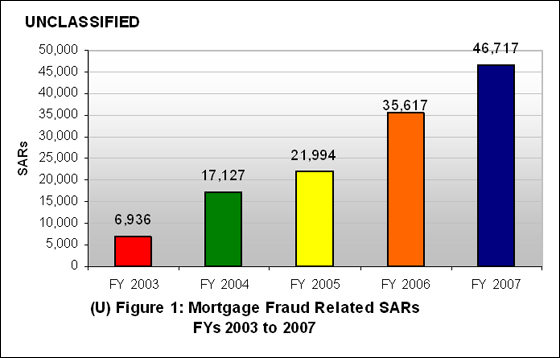
The dollar losses attributed to mortgage fraud
are unknown. However, 7 percent of SARs filed during FY 2007
indicated a dollar loss of more than $813 million (see figure 2)2.
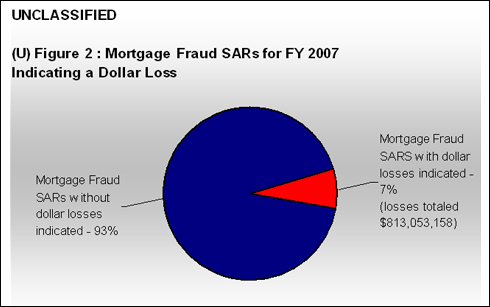
The fact that only 7 percent of SARs from financial institutions
documented
a loss may be attributed to the fact that losses were unknown
at the time of reporting, or fraud was discovered before loan
funding, and therefore a loss was not incurred. The $813 million
statistic
is significant, as it hints to the total amount of financial
institution
and industry entity losses not subject to SAR filing.
Mortgage Fraud in a Depressed Housing Market
During 2007, mortgage loan originations, including purchases and
refinances, were down from 2006 and foreclosures were up nationally,
contributing to a slump in the housing market. Many mortgage industry
professions are paid by commission. During declining markets, mortgage
fraud perpetrators may take advantage of industry personnel attempting
to generate loans to maintain current standards of living.
The housing market is expected to continue its downward trend.
The Mortgage Bankers Association (MBA) estimates that mortgage
loan originations will continue to decline through 2009 (see
figure 3).3

According to an MBA report from January 2008, existing home
sales are expected to decline by 13 percent during 2008 from 2007.
Likewise, new home sales are expected to decline 15 percent from
2007 figures. Median home prices are also expected to decline in
2008.4 The current and future market conditions will have mortgage
industry professionals pursuing a smaller pool of customers. As
such, professional fraudsters will devise new and improved schemes
to exploit the weaknesses in the housing market.5
The financial impact subprime lending has had on the mortgage
industry and the economy as a whole has been widely reported. The
subprime share of outstanding loans has more than doubled from
2003, putting a greater share of loans at a higher risk of failure
(see figure 4).6

Subprime mortgage loans are designed for persons
with blemished or limited credit histories. To compensate for the
increased credit risk, subprime loans carry a higher rate of interest
than prime loans.7 According to First American CoreLogic LoanPerformance
data, 64.5 percent of the securitized subprime loans originated
during 2005 had adjustable rates; 79.4 percent of these loans were
2/28 hybrid adjustable-rate loans (HARMS).8 These
HARMS had fixed mortgage rates for the first two years after
origination and were
subject to reset in 2007. Therefore, once the loan introductory “teaser
rate” expired, the rate was subject to increase.
Wall Street Journal, March 2008
“So far, banks and insurers have written down more
than $150 billion in securities tied to subprime-mortgage loans.”
- Excerpt from: Carrick Mollenkamp and Mark Whitehouse, “Banks
Fear a Deepening of Turmoil,” Wall Street Journal, 17 March
2008.
|
The upward
movement in interest rates and the declining housing market subjected
borrowers to increased payment shock and elevated the possibility
of default. The recent decline in the housing market and property
depreciation exacerbated the subprime problem. As properties depreciated
and demand decreased, property owners could not sell their homes
to satisfy their debts.
A report by MARI indicates that two factors pressured the industry
into non-traditional lending practices that contributed to fraud.
The first includes the persistent drive of mortgage lenders to
hasten the mortgage loan process, and the second involves the
escalation of home prices of recent years.9 According to congressional
statements,
by the spring of 2004, regulators began to document the fact
that lending standards were easing. Also, interest rates were
increasing.10
Notably, mortgage fraud SARs filed during 2004 more than doubled
from 2003 (see figures 1 and 4). These recent events likely resulted
in an increase in mortgage fraud as higher housing prices tempted
borrowers to exaggerate income and assets to qualify for a mortgage
loan. Mortgage fraud perpetrators also likely seized the opportunity
to take advantage of the relaxed lending practices to commit
fraud for profit.
Alt-A loans are designed for prime-quality borrowers, and
in many instances do not require documentation, making them ideal
for fraud exploitation. Alt-A loans include stated income, stated
income/stated asset or no income/no asset loans that are offered
by both prime and subprime lenders. BasePoint Analytics, a fraud
analysis and consulting service, analyzed loans that were originated
between 2002 and 2006; nearly 1 million Alt-A loans and 3 million
nonprime loans were evaluated. The relative fraud-loss rate of
Alt-A loans was more than three times higher than nonprime loans.
Losses within Alt-A loans were caused by income misrepresentations,
employment frauds, straw buyers, investor-related frauds, and occupancy
frauds.11 The Federal National Mortgage Association (Fannie Mae)
conducts random post purchase reviews. Statistics generated from
these reviews indicate that misrepresentations within Alt-A loans
are higher than the overall population of loans (see figure
5).12
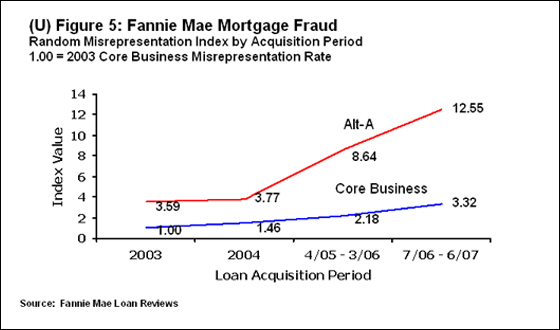
Top Areas for Mortgage Fraud
Data from law enforcement and industry sources were compared and
mapped to determine which areas of the country were most affected
by mortgage fraud during 2007. Information from the FBI, HUD-OIG,
FinCEN, Mortgage Asset Research Institute (MARI), Fannie Mae, RealtyTrac
Inc., Interthinx®, and Radian Guaranty Inc., indicated that
the top 10 mortgage fraud states for 2007 were Florida, Georgia,
Michigan,
California, Illinois, Ohio, Texas, New York, Colorado, and Minnesota
(see figures 6 and 7 for a breakdown of source data). Other states
significantly affected by mortgage fraud according to aforementioned
sources included Arizona, Maryland, Utah, Nevada, Missouri, Indiana,
Tennessee, Virginia, New Jersey, and Connecticut.
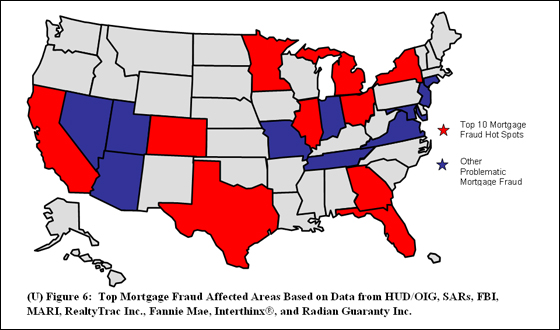
Analysis of available information indicated that mortgage fraud
was most concentrated in the north central region of the United
States (see figure 7). This region is followed by the west and
southeast regions.
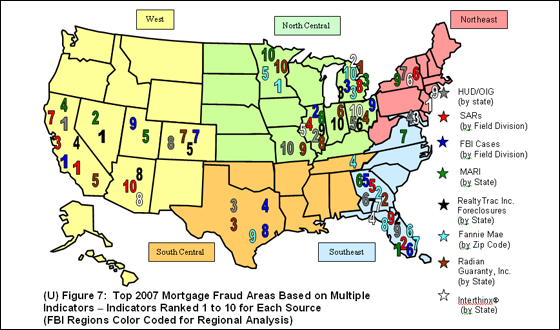
Breakdown of Sources Used to Identify Top Mortgage Fraud Areas
Federal Bureau of Investigation Regional analysis of FBI pending
mortgage fraud-related investigations as of FY 2007 revealed that
the north central region of the United States led the nation with
the most pending investigations. The north central region was followed
by the west, southeast, south central, and northeast, respectively
(see figures 7 and 8).
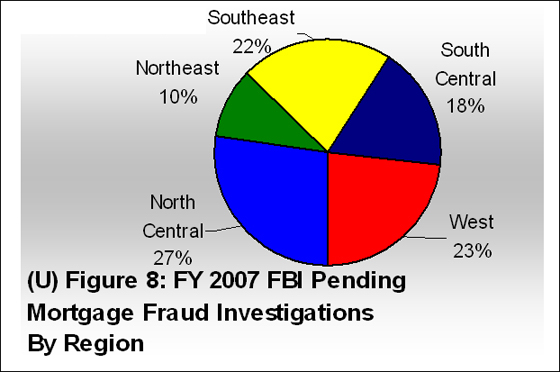
FBI mortgage fraud investigations at the end of FY 2007 totaled
1,204, a 47-percent increase from FY 2006 and a 176-percent increase
from FY 2003 (see figure 9).13 Fifty-six percent of pending FBI mortgage
fraud investigations in FY 2007 were associated with dollar losses
of more than $1 million (see figure 10). FBI field divisions that
ranked in the top 10 for pending investigations during FY 2007
included Los Angeles, Chicago, Detroit, Dallas, Atlanta, Miami,
Denver14, Houston, Cleveland and Salt Lake City15 (tied for 9th), respectively.16
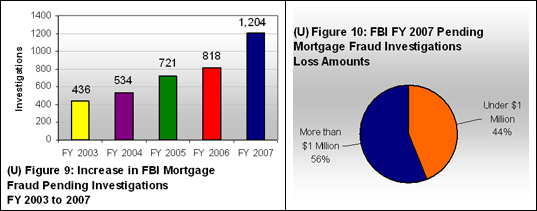
Financial Crimes Enforcement Network
According to SAR reporting, the Los Angeles, Miami, San Francisco,
Chicago, Atlanta, New York, Sacramento, Detroit, Tampa, and Phoenix
Divisions, respectively were the top 10 FBI field offices impacted
by mortgage fraud during FY 2007 (see figure 11).17
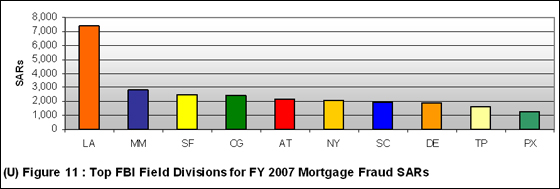
US Department of Housing and Urban Development - Office of Inspector
General
HUD-OIG is charged with detecting and preventing waste, fraud,
and abuse in relation to HUD programs. As part of this mission,
HUD-OIG investigates mortgage fraud related to Federal Housing
Administration (FHA) loans. As of 30 September 2007, HUD-OIG had
466 single family (SF) residential loan investigations pending.
In FY 2007, HUD-OIG opened 151 SF mortgage fraud investigations,
a decline from the 239 SF mortgage fraud investigations opened
during FY 2006. This decline can be attributed to the substantial
decline in FHA market share. One reason for the FHA loss of market
share was the increased prevalence of subprime loans from commercial
lenders; many of those who might typically have applied for FHA
loans instead opted for subprime loans. In addition, FHA loan levels
were often not competitive in many real estate markets. Consequently,
HUD-OIG witnessed a parallel decline in FHA mortgage
fraud investigations. Recently, FHA has made several significant
changes in its SF loan
program, including substantially increasing loan levels in high-cost
areas, and making efforts to have those currently holding subprime
loans, or facing foreclosure, to refinance those loans with FHA.
As a result, the FHA market share is expected to increase, with
a parallel increase anticipated for HUD-OIG’s investigative
case load.18
HUD-OIG’s top 10 mortgage fraud states based on investigations
opened during FY 2007 included Ohio, Maryland, Illinois, Georgia,
Texas, Virginia, California, North Carolina, Michigan, and New
York, respectively. Also, the top 10 state for pending investigations
during the same time period included California, Illinois, Texas,
Maryland, Ohio, Georgia, New York, Colorado, Florida, and Missouri.19
Mortgage Asset Research Institute
During 2007, Florida, Nevada, Michigan, California, Utah, Georgia,
Virginia, Illinois, New York, and Minnesota were MARI’s top
10 states for reports of mortgage fraud across all SF loan types (see
figure 12).20 MARI maintains the Mortgage Industry Data Exchange
(MIDEX) database which contains incidents of alleged mortgage fraud/misrepresentations
from hundreds of mortgage industry entities including Fannie Mae,
Freddie Mac, HUD, mortgage insurers, and numerous lenders. MARI
annually releases a report to the mortgage industry highlighting
the geographical distribution of mortgage fraud based on MIDEX
submissions. Individual states are ranked using the MARI Fraud
Index (MFI). The MFI is an indication of amount of mortgage fraud
found through MIDIX subscriber fraud investigations in various
geographical areas within a particular year relative to the amount
of loans originated. New states added to MARI’s top 10 for
2007 included Utah and Virginia.
Figure 12: MARI’s Top 10 States for 2007 Reported Fraud
in Single Family Loan Types
| Figure 12: MARI’s Top 10 States for 2007
Reported Fraud in Single Family Loan Types |
| State |
MFI Rank 2007 |
MFI Rank 2006 |
Florida |
1 |
1 |
Nevada |
2 |
6 |
Michigan |
3 |
3 |
California |
4 |
2 |
Utah |
5 |
11 |
Georgia |
6 |
4 |
Virginia |
7 |
14 |
Illinois |
8 |
8 |
New York |
9 |
9 |
Minnesota |
10 |
5 |
Interthinx® Interthinx® is a provider of proven risk mitigation and regulatory
compliance tools for the financial services industry. Data from
Interthinx® fraud detection tools (DISSCO and FraudGUARD?) include
nearly 2 million loan applications from more than 2,000 mortgage
originators and loan purchasers nationally. Loans are flagged for
possible fraudulent activity and scored as “Investigate” or “Critical
Risk” if they demonstrate high impact variances in employment/income,
identity, occupancy, straw-buyer, property valuation, or property
flipping. More than 22 percent of loans submitted to the Interthinx® mortgage fraud detection tools during 2007 had at least one high
impact variance in one of these categories. The top 10 states for
possible fraudulent activity based on 2007 loan application submissions
to Interthinx® were New Jersey, Michigan, Maryland, Florida, Illinois,
New York, Georgia, Arizona, Connecticut, and Ohio, respectively.21
Federal National Mortgage Association (Fannie Mae)
As of December 2007, the top 10 markets (by zip code area) for
mortgage loan misrepresentations according to Fannie Mae included
Minneapolis, Minnesota; Atlanta, Georgia; Detroit, Michigan; Memphis,
Tennessee; St. Paul, Minnesota; Pompano Beach, Florida; Miami,
Florida; Fort Myers, Florida; Houston, Texas; and Dearborn, Michigan.22
Fannie Mae is the nation’s largest mortgage investor. To
aid in mortgage fraud prevention and detection, the company publishes
a mortgage fraud newsletter that includes information concerning
misrepresentations discovered in loan files. Loans originated in
2006 through 2007 and reviewed by Fannie Mae through December 2007
were used to formulate a geographic top 10 list by zip code area
for concentrated mortgage loan misrepresentations (see figure
13).
| Figure 13: Fannie Mae Top 10 Zip Code Markets
for Misrepresentations |
| Rank for Number of Misrepresentations |
Top 10 Zip Code Markets
(first three digits
of zip code) |
Type of Misrepresentation |
1
|
Minneapolis, Minnesota (554)
|
Credit and SSN
|
2
|
Atlanta, Georgia (303)
|
Credit and Income
|
3
|
Detroit, Michigan (482)
|
Credit and Value/Property
|
4
|
Memphis, Tennessee (381)
|
Income and Assets
|
5
|
St. Paul, Minnesota (551)
|
Credit and SSN
|
6
|
Pompano Beach, Florida (330)
|
Income and Credit
|
7
|
Miami, Florida (331)
|
Income and Assets
|
8
|
Fort Myers, Florida (339)
|
Credit and Occupancy
|
9
|
Houston, Texas (770)
|
Income and Credit
|
10
|
Dearborn, Michigan (481)
|
Credit and Income
|
Delinquency, Default, and Foreclosure: Results of Fraud
BasePoint Analytics, a fraud analysis and consulting service,
analyzed more than 3 million loans and found that between 30 and
70 percent of early payment defaults (EPDs) are linked to significant
misrepresentations in the original loan applications.23 Radian Guaranty,
Inc. is a leading provider of mortgage insurance which protects
lenders against loan default. Statistics maintained by the company
indicated that Florida, California, Michigan, Texas, Ohio, Illinois,
Georgia, New York, Pennsylvania, and New Jersey, respectively were
the top 10 states for the percentage of EPDs as of 31 December
2007.24 Radian Guaranty, Inc. also ranked more than half of these
states in their top 10 for percent of mortgage frauds uncovered,
which suggests that EPDs are potential fraud indicators. As of
31 December 2007, Radian Guaranty, Inc.’s top 10 states for
percent of overall frauds uncovered included Michigan, Georgia,
Texas, Ohio, California, Indiana, Colorado, Illinois, Missouri,
and Minnesota, respectively (see figure 14).25
Figure 14: Radian Guaranty, Inc. Top States for
EPDs and Mortgage Fraud
(States in both columns are bold text) |
| Rank |
Radian Guaranty, Inc.
Top States for EPDs |
Radian Guaranty, Inc.
Top Mortgage Fraud States |
1
|
Florida
|
Michigan
|
2
|
California
|
Georgia
|
3
|
Michigan
|
Texas
|
4
|
Texas
|
Ohio
|
5
|
Ohio
|
California
|
6
|
Illinois
|
Indiana
|
7
|
Georgia
|
Colorado
|
8
|
New York
|
Illinois
|
9
|
Pennsylvania
|
Missouri
|
10
|
New Jersey
|
Minnesota
|
During 2007, there were more than 2.2 million foreclosure filings
reported on approximately 1.29 million properties nationally, up
75 percent from 2006. More than 1 percent of all US households
were in some stage of foreclosure, including default notices, auction
sale notices, and bank repossessions, up from 0.58 percent in 2006.26
Properties in some stage of foreclosure for 2007 surpassed 2006
figures for all four quarters (see figure 15). The top 10 states
for percent of households in some stage of foreclosure during 2007
were Nevada (3.376 percent), Florida (2.002 percent), Michigan
(1.947 percent), California (1.921), Colorado (1.919), Ohio (1.797),
Georgia (1.566), Arizona (1.516), Illinois (1.250), and Indiana
(1.027).27
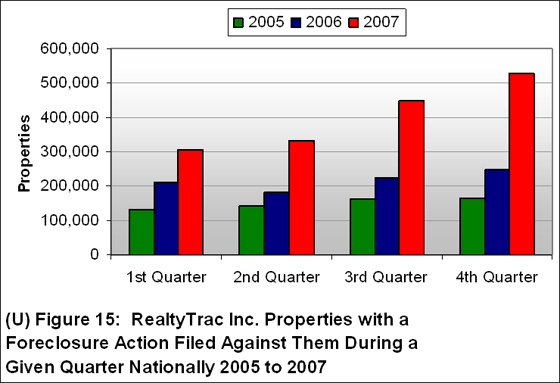
Emerging Schemes
The downward trend in the housing market provides an ideal climate
for mortgage fraud perpetrators to employ a myriad of schemes suitable
to a down market. Several of these schemes have emerged with the
potential to spread as the recent rise in foreclosures, depressed
housing prices, and decreased demand place pressure on lenders,
builders, and home sellers. As lending practices tighten, in response
to the subprime lending crisis, fewer loans will be originated.
Perpetrators will seek alternative methods of defrauding mortgage
loan products. Identity theft is historically a popular tool for
use in mortgage fraud schemes. As financial institutions begin
to enforce higher lending standards, the identities of individuals
with good credit will increase in value to perpetrators. As such,
individuals with good credit will likely be at a more significant
risk for identity theft and mortgage fraud schemes, and the continued
vulnerability of identifying information will allow perpetrators
the accesses necessary to commit such schemes.

Builder-Bailout Schemes
Builders are employing builder-bailout schemes to offset losses
and circumvent excessive debt and potential bankruptcy as home
sales suffer from escalating foreclosures, rising inventory, and
declining demand. Builder-bailout schemes are common in any distressed
real estate market and typically consist of builders offering excessive
incentives to buyers, which are not disclosed on the mortgage loan
documents. Builder-bailout schemes often occur when a builder or
developer experiences difficulty selling their inventory and uses
fraudulent means to unload it. In a common scenario, the builder
has difficulty selling property and offers an incentive of a mortgage
with no down payment. For example, a builder wishes to sell a property
for $200,000. He inflates the value of the property to $240,000
and finds a buyer. The lender funds a mortgage loan of $200,000
believing that $40,000 was paid to the builder, thus creating home
equity. However, the lender is actually funding 100 percent of
the home’s value. The builder acquires $200,000 from the
sale of the home, pays off his building costs, forgives the buyer’s
$40,000 down payment, and keeps any profits. If the home forecloses,
the lender has no equity in the home and must pay foreclosure expenses.
Seller Assistance Scams
Mortgage fraud perpetrators are exploiting the depreciating housing
market by assisting sellers and providing buyers to conduct property
sales that are based on inflated appraisals. In a typical seller
assistance scam, a perpetrator solicits an anxious seller or his
real estate agent and offers to find a property buyer. The perpetrator
negotiates the amount that the property seller is willing to accept
for the home. The perpetrator then hires an appraiser to inflate
the property’s value. The property is sold at the inflated
rate to a buyer who is recruited by the perpetrator. The buyer
takes out a mortgage for the inflated amount. The seller then receives
the asking price for the home, and the perpetrator pockets a “servicing
fee,” the difference between the home’s market value
and the fraudulently inflated value. When the mortgage defaults,
the lender forecloses on the house, but is unable to sell it for
the amount owed as a result of the inflated value.
Seller assistance programs may be easily perpetrated in any
depressed market where sales of homes have languished and sellers
are motivated. The current instability in the housing market and
mortgage industry has created an ideal environment for perpetration
of this fraud. Seller assistance schemes eliminate the need for
the two property transactions that are required for illegal property
flipping, which involves first purchasing and then selling a property.
Some industry sources have coined the phrase “cash back purchase” or “one
transaction flip” to describe the scheme because it eliminates
the need for two property transactions to generate a profit.
Short-sale Schemes
Figure 17: Example of a fraudulent short sale:
 Perpetrator
of a short-sale scheme; Perpetrator
of a short-sale scheme;
 Perpetrator recruits a straw buyer to purchase a property. Perpetrator recruits a straw buyer to purchase a property.
 Perpetrator has straw buyer secure a mortgage for 100% of
the property’s value. Perpetrator has straw buyer secure a mortgage for 100% of
the property’s value.
 Perpetrator may have a straw buyer refinance the home and
obtain $30,000 for “repairs.” Perpetrator may have a straw buyer refinance the home and
obtain $30,000 for “repairs.”
 Perpetrator pockets the $30,000. No repairs are made. Perpetrator pockets the $30,000. No repairs are made.
 No payments are made so the mortgage will default. No payments are made so the mortgage will default.
 Straw buyer informs the lender that the home will foreclose
and recommends the perpetrator as a potential buyer in a
short sale. Straw buyer informs the lender that the home will foreclose
and recommends the perpetrator as a potential buyer in a
short sale.
 Perpetrator approaches lender prior to foreclosure and offers
to pay less for the home than would otherwise be received
in a competitive foreclosure sale. Perpetrator approaches lender prior to foreclosure and offers
to pay less for the home than would otherwise be received
in a competitive foreclosure sale.
 Lender agrees to the short sale not knowing that the mortgage
payments were deliberately not made to create this short-sale
situation. Lender agrees to the short sale not knowing that the mortgage
payments were deliberately not made to create this short-sale
situation.
 Perpetrator sells the property at actual value for a profit,
or has the property artificially inflated to conduct an illegal
property flip. Perpetrator sells the property at actual value for a profit,
or has the property artificially inflated to conduct an illegal
property flip.
|
Short-sale schemes are desirable to mortgage
fraud perpetrators because they do not have to competitively bid
on the properties
they purchase, as they do for foreclosure sales. Perpetrators also
use short sales to recycle properties for future mortgage fraud
schemes. Short-sale fraud schemes are difficult to detect since
the lender agrees to the transaction, and the incident is not reported
to internal bank investigators or the authorities. As such, the
extent of short sale fraud nationwide is unknown. A real estate
short sale is a type of pre-foreclosure sale in which the lender
agrees to sell a property for less than the mortgage owed. In a
typical short sale scheme, the perpetrator uses a straw buyer to
purchase a home for the purpose of defaulting on the mortgage.
The mortgage is secured with fraudulent documentation and information
regarding the straw buyer. Payments are not made on the property
loan so that the mortgage defaults. Prior to the foreclosure sale,
the perpetrator offers to purchase the property from the lender
in a short-sale agreement. The lender agrees without knowing that
the short sale was premeditated. The mortgage owed on the property
often equals or exceeds 100 percent of the property’s equity (see figure17).
Foreclosure Rescue Scams
As in 2006, foreclosure rescue scams continued to be problematic
in 2007. Escalating foreclosures provide criminals with the opportunity
to exploit and defraud vulnerable homeowners seeking financial
guidance. The perpetrators convince homeowners that they can save
their homes from foreclosure through deed transfers and the payment
of up-front fees. This “foreclosure rescue” often involves
a manipulated deed process that results in the preparation of forged
deeds. In extreme instances, perpetrators may sell the home or
secure a second loan without the homeowners’ knowledge, stripping
the property’s equity for personal enrichment.
Identity Theft Used to Drain Home Equity Lines of Credit
HELOC Vulnerabilities
HELOCs differ from standard home equity loans because the homeowner
may borrow against the line of credit over a period of time using
a checkbook or credit card. They are aggressively marketed by
lenders as an easy, fast, and inexpensive means to obtain funds.
As such, an individual may open a HELOC account much like they
do a credit card. The funds may not be accessed for an extended
period of time, and the account balance may not be regularly
verified. |
Stolen customer identification information is
being used to compromise Home Equity Lines of Credit (HELOC) accounts.
To facilitate this
scheme, perpetrators pose as customers to establish HELOC Internet
account services and manipulate customer account verification
processes, including rerouting telephone calls, forging signatures,
using
passwords, and reciting recent account history. For example,
a perpetrator uses the account holder identification information
to contact a financial institution and request an advance of
funds
on a HELOC account. Once the advance is granted, the perpetrator
sends a facsimile to the financial institution requesting that
the funds be wire transferred to another account. On receipt
of the facsimile request, the financial institution contacts the
account
holder using the telephone number on record to verify the transaction.
However, the call is unknowingly forwarded to the perpetrator
who verifies the account holder’s information to complete
the wire transfer.
FBI Response As mortgage fraud crimes escalate, the burden on federal law enforcement
increases. With the anticipated upsurge in mortgage fraud cases,
the FBI employed additional strategies to proactively address the
crime problem. The FBI works with the Department of Justice (DOJ)-Mortgage
Fraud Working Group on a number of mortgage fraud related issues,
including the creation and finalization of standard loss valuation
criteria associated with mortgage fraud violations, and assisting
the banking industry with the construction of a centralized repository
of mortgage-related documentation.
The FBI also held a mortgage fraud summit with FBI Supervisory
Special Agents to address the most severe mortgage fraud problems
nationally. Currently the FBI has mortgage fraud working groups
or task forces in 32 field divisions, including Anchorage, Albuquerque,
Atlanta, Buffalo, Charlotte, Chicago, Cincinnati, Cleveland, Detroit,
Dallas, Denver, El Paso, Honolulu, Houston, Indianapolis, Jackson,
Kansas City, Louisville, Memphis, Miami, Minneapolis, Milwaukee,
Portland, Pittsburgh, Philadelphia, Phoenix, Sacramento, San Diego,
San Francisco, Salt Lake City, Tampa, and Washington, DC. The FBI
continues to encourage the use of undercover operations as an effective
technique to address mortgage fraud.
The FBI continues to work closely with its government and
industry partners to ensure that pertinent data is shared in a
timely fashion. Efforts are ongoing to educate the American public
regarding mortgage fraud crimes and perpetrators. Analytical products
are routinely disseminated to a wide audience. Working groups and
task forces remain ideal forms from which to coordinate multi-agency,
multi-jurisdictional investigations into mortgage fraud matters.
|


